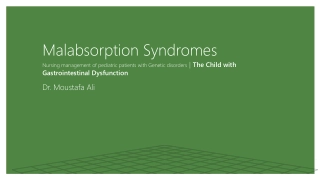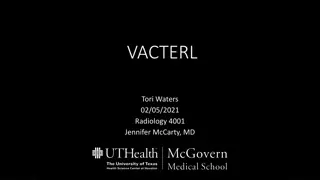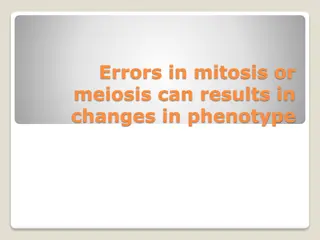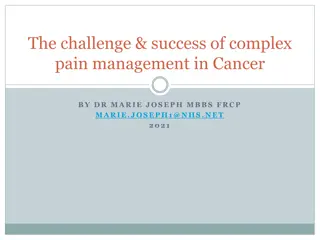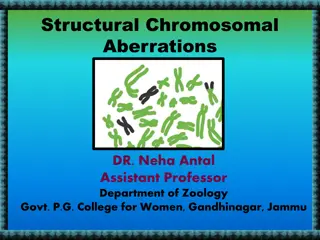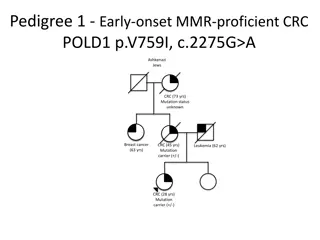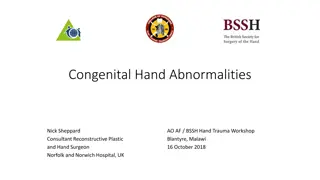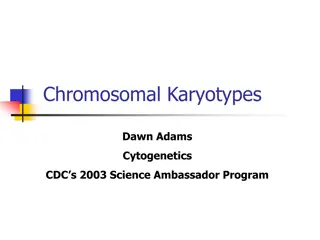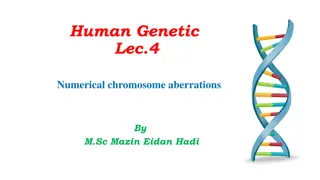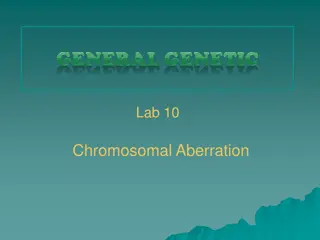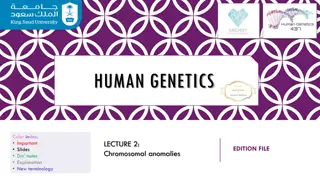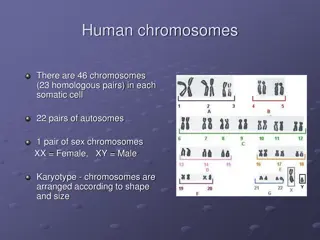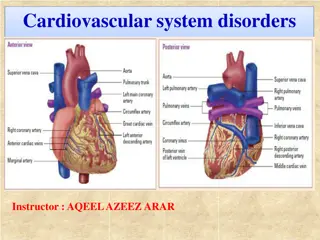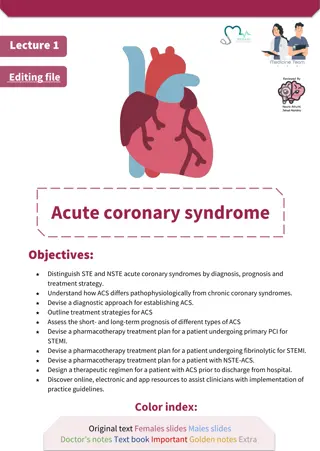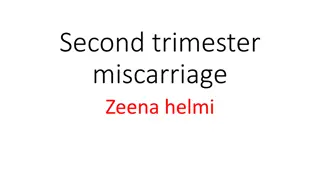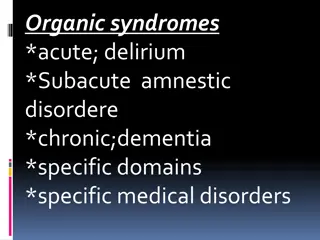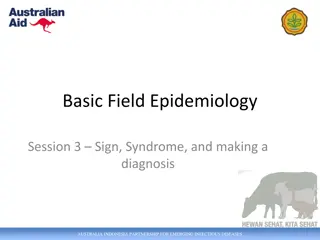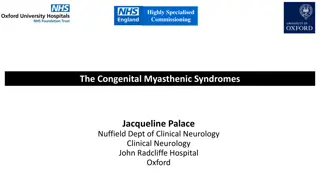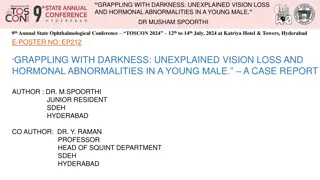Understanding Chromosomal Abnormalities and Syndromes
Human cells have 22 pairs of autosomes and one pair of sex chromosomes, totaling 46. Karyotypes help diagnose chromosomal abnormalities by aligning chromosomes in size order. Nondisjunction during meiosis can lead to abnormal chromosome numbers in gametes. Disorders like Down Syndrome, XYY Syndrome, Turner Syndrome, and Klinefelter Syndrome are caused by chromosomal abnormalities.
Download Presentation

Please find below an Image/Link to download the presentation.
The content on the website is provided AS IS for your information and personal use only. It may not be sold, licensed, or shared on other websites without obtaining consent from the author. Download presentation by click this link. If you encounter any issues during the download, it is possible that the publisher has removed the file from their server.
E N D
Presentation Transcript
13.1. Considering the Chromosomes A. Karyotypes
1. Human cells have 22 pairs of autosomes, one pair of sex chromosomes; total of 46. (Fig. 13.1) 2. Karyotypes shows chromosomes paired according to size, shape, and appearance in metaphase.
d. Chromosomes in a karyotype are aligned from largest to smallest. e. A karyotype can be used to diagnose chromosomal abnormalities. 3. Sex chromosomes of a normal male are X and Y; a normal female has two X chromosomes. 4. All chromosomes besides X and Y are autosomes.
B. Nondisjunction Causes Abnormalities 1. Nondisjunction during meiosis causes an abnormal chromosome number in gametes produced. 2. Nondisjunction is a failure of one or more chromosomes to separate. 3. Nondisjunction can occur during meiosis I or during meiosis II. (Fig. 13.2a) 4. Results in gametes with either too few (n - 1) or too many (n + 1) chromosomes. 5. If abnormal gametes fertilize normal gametes, a monosomy (2n - 1) or trisomy (2n + 1) results. 6. Study of spontaneous abortions suggests many trisomies and nearly all monosomies are fatal.
C. Down Syndrome 1. Down syndrome is most common autosomal trisomy, involves chromosome 21. . 2. Most often, Down syndrome is due to nondisjunction during gametogenesis. a. In 23% of cases, the sperm had the extra chromosome 21. b. In 5% of cases, there is translocation where chromosome 21 is attached to chromosome 14. 3. Chances of a woman having a Down syndrome child increase with age. 4. Chorionic villi sampling testing or amniocentesis and karyotyping detects a Down syndrome child. 5. Down syndrome child has tendency for leukemia, cataracts, faster aging, and mental retardation. 6. Gart gene, located on bottom third of chromosome 21, leads to high level of purines; is associated with mental retardation; future research may lead to suppression of this gene.
D. X and Y Numbers Also Change : 1. XYY males with Jacob syndrome have two Y chromosomes instead of one. a. Usually taller than average; suffer from persistent acne; tend to have lower intelligence. b. Earlier claims that XYY individuals were likely to be aggressive are not correct. 2. Turner (XO) syndrome :- females have only one sex chromosome, an X. . a. Turner females are short, have a broad chest and webbed neck. b. Ovaries of Turner females never become functional; therefore, do not undergo puberty. 3. Klinefelter syndrome males have one Y chromosome and two or more X chromosomes.(XXY or XXXY) :- a. Affected individuals are sterile males; testes are underdeveloped. . b. Individuals have large hands and feet and long arms and legs. 4. Triplo-X females : ( XXX , More ..) :- have three or more X chromosomes. a. There is no increased femininity; most lack any physical abnormalities. b. May experience menstrual irregularities, including early onset of menopause.
E. Fragile X Syndrome : 1. X chromosome is nearly broken; most often found in males. 2. As children: hyperactive or autistic; delayed speech. 3. As adults: large testes, unusually protruding ears. 4. Occurs in females, but symptoms are less severe. 5. Passes from symptomless male carrier to grandson.\
13.2. Considering Autosomal Traits : A. Predicting Likely Offspring 1. First determine genotypes of parent (EE, Ee or ee); this determines gametes produced (E or e). 2. Punnett square provides phenotypic ratio if all sperm are given equal chance to fertilize all eggs. a. Two heterozygous parents can produce a 3:1 ratio. . b. A heterozygous with homozygous recessive cross produces a 1:1 ratio.
B. Some Disorders Are Dominant 1. Neurofibromatosis a. This is an autosomal dominant disorder that affects one in 3,000 people. b. Affected individuals have tan skin spots at birth, which develop into benign tumors. c. Neurofibromas are comprised of nerve cells or other cell types. d. Most case symptoms are mild, patients live a normal life; sometimes symptoms are severe: 1) skeletal deformities, including a large head. 2) eye and ear tumors that can lead to blindness and hearing loss. 3) learning disabilities and hyperactivity. e. Gene that codes for neurofibromatosis is huge; includes three smaller nested genes. 1) It is a tumor-suppressor gene active in controlling cell division. 2) When it mutates, a benign tumor results.
2. Huntington Disease a. This is also an autosomal dominant disorder that affects one in 20,000 people. b. It leads to progressive degeneration of brain cells, which in turn causes severe muscle spasm, personality disorders, and death in 10 -15 years from onset. . c. Most appear normal until they are of middle age and already have had children who might carry the gene; occasionally, first signs of the disease are seen in teenagers or even younger. d. The gene for Huntington disease is located on chromosome 4. e. Gene contains many repeats of base triplet CAG (cytosine, adenine, guanine); normal persons have 11 34 copies; affected persons have 42 120 or more copies. f. Severity and time of onset of associated disorders depend on number of triplet repeats. g. Apparently, persons most at risk are those inheriting the gene from their fathers.
C. Some Disorders Are Recessive 1. Tay-Sachs Disease a. Usually occurs among Jewish people in the U.S. of central and eastern European descent. b. Symptoms are not initially apparent; infant's development begins to slow at 4-8 months, neurological and psychomotor difficulties become apparent, child gradually becomes blind and helpless, develops seizures, eventually becomes paralyzed, dies by age of three or four. c. Results from lack of enzyme hexosaminidase A (Hex A) and subsequent storage of its substrate, glycosphingolipid, in lysosomes. d. Primary sites of storage are cells of the brain; accounts for progressive deterioration. e. No treatment or cure; prenatal diagnosis is by amniocentesis and chorionic villi sampling.
2. Cystic Fibrosis a. This recessive autosomal disease is most common lethal genetic disease in Caucasians in U.S. b. About 1 in 20 Caucasians is a carrier, and about 1 in 2,500 births has this disorder. c. Involves production of viscous form of mucus in the lungs and pancreatic ducts. 1) Resultant accumulation of mucus in the respiratory tract interferes with gas exchange. 2) Digestive enzymes must be mixed with food to supplant the pancreatic juices. d. New treatments have raised average life expectancy to 28 years. e. Research has demonstrated chloride ions (Cl-) fail to pass plasma membrane proteins. f. Since water normally follows Cl- , lack of water in the lungs causes thick mucus. g. Cause is mutated gene on chromosome 7; attempt to insert gene into nasal epithelium has had limited success. h. Genetic testing for adult carriers and fetuses is possible.
3. Phenylketonuria (PKU) a. PKU occurs 1 in every 5,000 births; it is most common inherited disease of nervous system. b. Lack of enzyme needed to metabolize amino acid phenylalanine results in accumulation of the amino acid in nerve cells of the brain; this impairs nervous system development. c. PKU is caused by a mutated gene on chromosome 12. d. Now newborns are routinely tested in hospital for high levels of phenylalanine in the blood. e. If infant has PKU, child is placed on diet low in phenylalanine until brain is fully developed.
D. Pedigree Charts 1. Pedigree charts show pattern of inheritance within a family. 2. Males are designated by squares, females by circles; shaded circles and squares are affected individuals; the line between square and circle represents a union; vertical line leads to offspring. 3. A carrier is a heterozygous individual who has no apparent abnormality but can pass on an allele for a recessively inherited genetic disorder. 4. Autosomal dominant and autosomal recessive alleles have different patterns of inheritance.
a. Characteristics of autosomal dominant disorders . 1) Affected children usually have an affected parent. 2) Heterozygotes are affected. 3) Two affected parents can produce unaffected child; two unaffected parents will not have affected children. b. Characteristics of autosomal recessive disorders . 1) Most affected children have normal parents since heterozygotes have a normal phenotype. 2) Two affected parents always produce an affected child. 3) Close relatives who reproduce together are more likely to have affected children. 4). If chance of having affected child is 1/4, a couple could still have 4 children, all with condition.
c. Other Inheritance Patterns 1. Polygenic Traits a. Polygenic inheritance occurs when one trait is governed by two or more sets of alleles. b. Dominant alleles have a quantitative effect on the phenotype: each adds to the effect. c. Result is a continuous variation in phenotypes: a bell-shaped curve. d. A hybrid cross for skin color provides a range of intermediates. e. Includes cleft lip, clubfoot, hypertension, diabetes, schizophrenia, allergies and cancers. f. Behavioral traits including suicide, phobias, alcoholism, and homosexuality may be associated with particular genes but are not likely completely predetermined.
2. Multiple Alleles a. Occur where a gene has three or more alternative expressions (alleles). b. The ABO system of human blood type is a multiple allele system. 1) Two dominant alleles (A and B) code for presence of A and B antigens on red blood cells. 2) Also includes recessive allele (o) coding for no A or B antigens on red blood cells. 3) As a result, there are four possible phenotypes (blood types): A, B, AB, and O
3. Sickle-cell disease is a blood disorder controlled by incompletely dominant alleles. a. HbAHbA individuals are normal; HbSHbS have the sickle-cell disease; HbAHbS have sickle-cell trait. b. With sickle-cell disease, red blood cells are irregular in shape (sickle-shaped) rather than biconcave, due to abnormal hemoglobin that the cells contain. c. Due to irregular shape, sickle-shaped red blood cells clog vessels and break down; results in poor circulation, anemia, low resistance to infection, hemorrhaging, damage to organs, jaundice, and pain in abdomen and joints. d. Persons heterozygous for sickle-cell (HbAHbS) are usually asymptomatic unless stressed. e. In malaria regions of Africa, infants heterozygous (HbAHbS) for sickle-cell allele have better chance of surviving; malaria parasite dies as potassium leaks from sickled cells. f. Bone marrow transplants pose high risks; other research focuses on fetal hemoglobin, etc.
13.3. Considering Sex-Linked Traits : A. Sex Chromosomes 1. Sex chromosomes (X and Y) contain genes just as autosomes do. 2. The Y chromosome contains the SRY gene (sex-determining region of Y) 3. Traits controlled by alleles on sex chromosomes are sex-linked. 4. Since Y chromosome is smaller, most sex- linked genes are on X chromosome.
B. X-Linked Alleles 1. Males receive X-linked traits from mother, source of male's only X chromosome. 2. If female shows a recessive sex-linked trait, her father must have it and her mother is a carrier. C. Some Disorders Are X-Linked. X linked recessive genetic disorders pedigree chart: More males than females are affected An affected son can have parents who have the normal phenotype For a female to have the characteristic, her father must also have it. Her mother must have it or be a carrier The characteristic often skips a generation from the grandfather to the grandson If a woman has the characteristic, all of her sons will have it
1. Color Blindness a. Can be X-linked recessive disorder involving mutations of genes coding for green or red- sensitive cone cells, resulting in inability to perceive green or red, respectively. . b. The possible genotypes for color blindness are as follows: 1) XB XB = a female who has normal color vision. 2) XB Xb = a carrier female who has normal color vision. 3) Xb Xb = a female who is color blind. 4) XBY = a male who has normal color vision. 5) XbY = a male who is color blind.
2. Muscular Dystrophy a. Duchenne muscular dystrophy is most common form; characterized by wasting away of muscles, eventually leading to death; it affects one out of every 3,600 male births. b. X-linked recessive disease involves a mutant gene that fails to produce protein dystrophin. = Symptoms (e.g., waddling gait, toe walking, frequent falls, difficulty in rising) soon appear. Muscle weakens until the individual is confined to a wheelchair; death usually occurs by age 20. e. Affected males are rarely fathers; the gene passes from carrier mother to carrier daughter.
3. Hemophilia a. About one in 10,000 males is a hemophiliac with impaired ability of blood to clot. b. Hemophilia has two types: Hemophilia A is due to absence of clotting factor IX (9) ; Hemophilia B is due to absence of clotting factor VIII (8) . c. Hemophiliacs bleed externally after an injury and also suffer internal bleeding around joints. d. Hemorrhages stop with transfusions of blood (or plasma) or concentrates of clotting protein. e. Hemophiliacs were at high risk of AIDS if receiving blood or using blood concentrate to replace clotting factors. f. Factor VIII is now available as a genetic engineering product. g. Of Queen Victoria's 26 offspring, 5 grandsons had hemophilia, and 4 granddaughters were carriers.
D. Some Traits are Sex-influenced 1. Some genes not located on the X or Y chromosomes are expressed differently in the two sexes. 2. Male pattern baldness is caused by an autosomal allele that is dominant in males and due to presence of testosterone. Q: regarding pedigree chart ;how you might distinguish an autosomal dominant trait from an autosomal recessive trait ,draw out line and mention some disorders for each Q: Discuss the following statement: Work by Thomas Hunt Morgan confirmed genes were on X chromosomes.
Thank you for listening Thank you for listening


